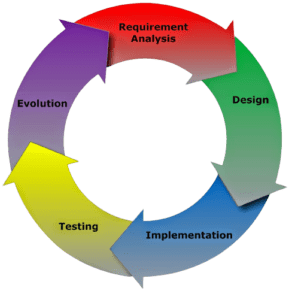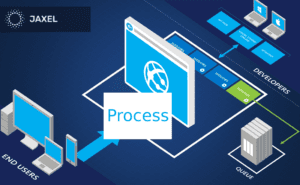Software Development Life Cycle
The Software Development Life Cycle is in use by developers to design, test, and develop software. This blog is helpful to know the 7 phases of the development. The Software Development Life Cycle is normally long and difficult. But, the project managers can formulate the best development process. They design, test, and develop the system with greater efficiency and quality. The system development life cycle makes developers able to change new projects into an operational one. Moreover, it is a multistep process with a unique methodology.
The process is ideal for technical and non-technical activities to meet business needs. Traditionally, there are 7 phases of Software Development Life Cycle that are helpful to achieving specific goals. With the help of these phases, users can understand the activities of the system. In this blog, you will learn everything about the system development cycle. So, let’s discuss the phases to improve the system functionality.

Phases:
The development life cycle steps are useful to provide a framework for the system quality. Similar to other projects, this system also uses IT projects. Below are the 7 phases of system development for system progress.
Strategic Plan:
Planning is the first phase in the system development process. The purpose of planning is to identify the need for business strategies. It is one of the best development life cycle steps to improve or modify the service. Additionally, the planning stage is helpful for developers to plan for the upcoming projects. It also helps to define the scope and problems of the existing system. Moreover, you can know the system objectives with planning. By making effective planning for the development cycle, you can secure funding and resources. Thus, the planning is the first phase of the program development life cycle.
System Requirements and Analysis:
The second phase of system development is where the business will work on its needs and problems. The analysis stage includes gathering all the details required for the new system. Possible solutions are analyzed to identify the best solution for the development of life cycle models. In this phase, the team considers the project needs and solutions. In addition, knowing systems requirements would be helpful to determine the business objectives. You can use business analysis to meet your business requirements. Different development life cycle tools are specific to this phase. Some of the tools are:
- Requirements gathering
- CASE
- Structured analysis
The basic purpose of this phase is that everyone will understand the detailed requirements.

System Design:
One of the 7 phases of the Software Development Life Cycle is system design. The design is ideal for necessary features, specifications, and operations. It is the most significant step for end-users to determine the business needs for the proposed system. In this stage of the website development life cycle, you will have to consider structure, processing, and components to achieve system objectives.
During this phase, the team will be focused on application programming and architecture. Moreover, it is the ultimate way to define a programming language and perform specific tasks. In this phase of the program development life cycle, the use of a UX prototype will be beneficial for your business. When design and prototype are done efficiently, you will be able to get the best benefits for business.
Development:
The fourth step of the development life cycle model is the development phase. In this stage, the database administrator, software, and network engineer develop applications depending on system design. Additionally, they use different languages and databases. The developers select the right programming language according to the software needs and specifications. In addition to this, the engineers follow coding standards to complete the application development. After the development life cycle, you can integrate modules and sub-modules to detect errors. Moreover, the developers also fine-tune the physical configuration of the software. Focused training can be a huge advantage of this phase.
Testing Stage:
The development of software is not the end. So, testing is one of the 7 phases of the Software Development Life Cycle. The system should be tested to ensure there are no issues. In addition, testing is ideal to make sure end-users will not experience negative effects. During the testing of the website development cycle, developers will use software to detect bugs and fix issues. It’s ideal to check the overall software that is defined in SRS documents. Depending upon the developer’s skills, the difficulty of the software can either be short or take a long time. Developers perform testing repeatedly until users are not fully satisfied. Validation and verifications are helpful to make sure successful completion of the program.

Implementation:
Implementation is one of the 7 phases of Software Development Life Cycle. This phase involved the installation of a newly formulated system. In addition, implementation puts the project into production by moving components and data from the old to the new system. Both end-users and system analysts should check the project realization with changes.
The coding is also a part of the implementation. After design features, you need to change the code as well. With the help of coding, you will be able to design computer languages. The tasks are divided into units or modules. After that, it is assigned to the different developers. The developers build the system by writing code with the help of programming languages. Moreover, developers use different tools like compilers, interpreters, and debuggers for code implementation. Implementation is one of the longest stages of the development life cycle steps. When any modification is required, the developer shows the work to the business analysts.
Operation and Maintenance:
The last stage of the development life cycle models is operation and maintenance. After the successful implementation of the system, the maintenance stage will start. The purpose of this phase is to operate and maintain the system regularly. Moreover, it includes new requirements such as necessary updates. This phase also ensures the system’s functionality by improving the hardware and updating the system. The developers will check the overall system and security technology. When you need a change, the developers will be responsible. Thus, there should be a yearly or monthly contract to maintain the system. However, after the completion of this phase, the contract may be extended depending upon the agreement between both parties.

Conclusion:
If a company needs a change during any stage of the development life cycle, the business has to go through all the above phases. The life cycle of any project can be a time-consuming process. Moreover, some steps are more crucial to handle. The developers are experts in managing all these tasks and projects. So, if you want a customized software solution, you need a developer. The development team in IT and other industries will be beneficial for your website development life cycle. As a result, your company will get benefits. Therefore, use the above phases in your development life cycle to get the best results.









